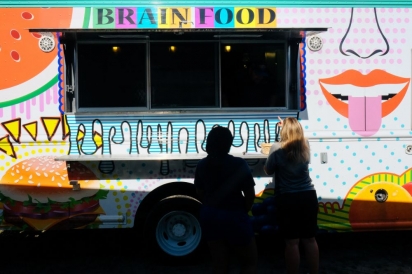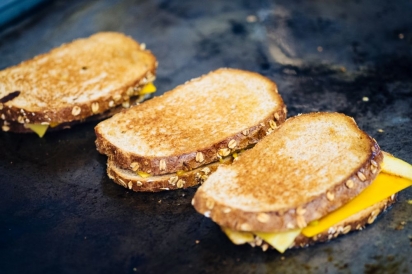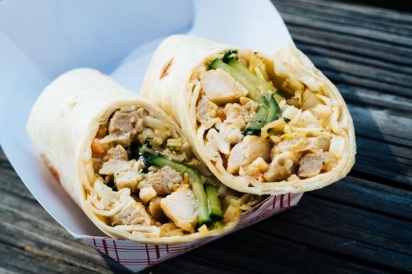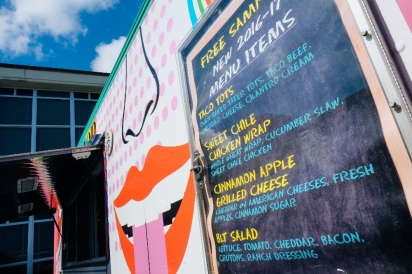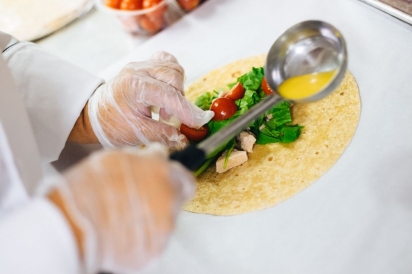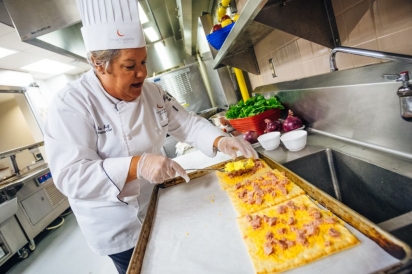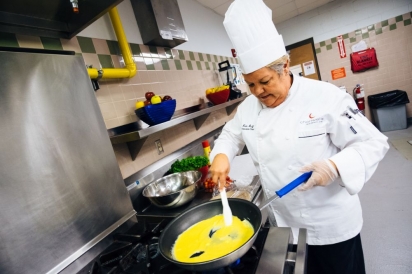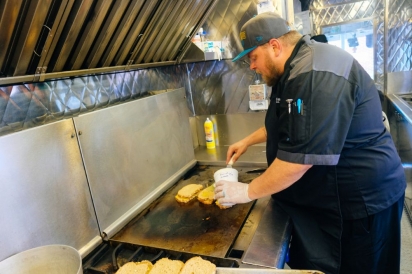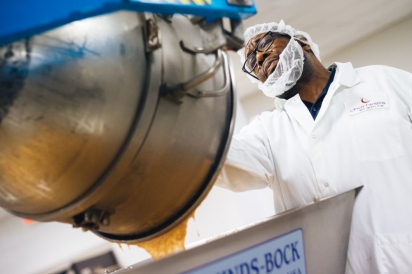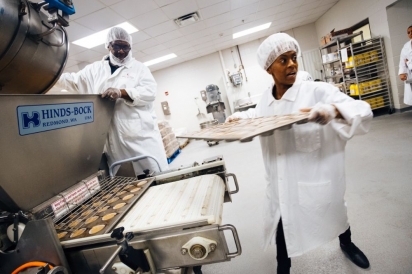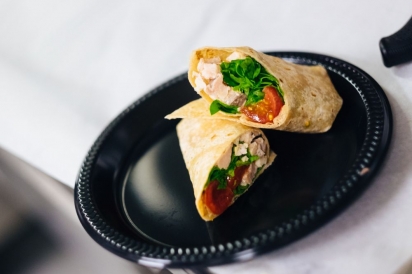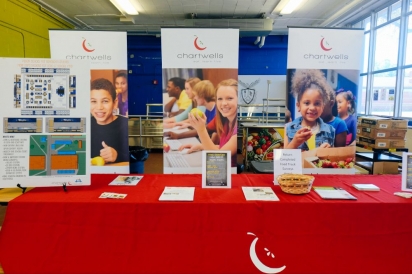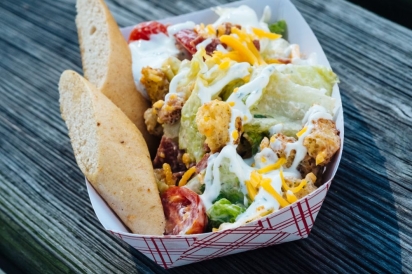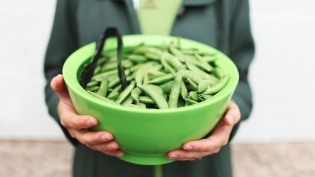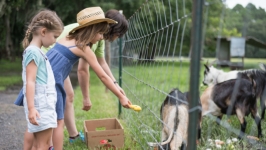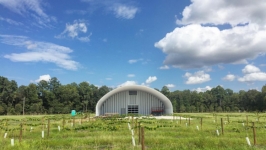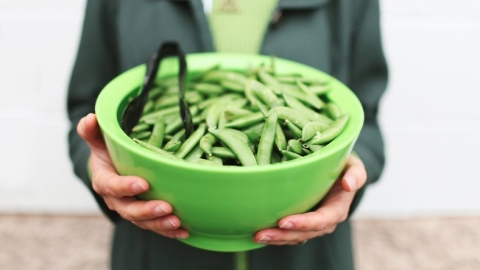The New School Cafeteria
Getting school lunch brings back memories of choosing between day-old pizza, stale tater tots or a mysterious selection of veggies and meat. Walk into any lunch room in a Duval County school today, however, and it’s a different place.
A typical day may bring a chef demonstration into a middle school lunch room. The next day, students might be lining up for food truck fare. Another day might bring students out to the school garden to see how the food they’re consuming lands on their plates. And these are just a few of the changes Duval County Public Schools have made to the menu over the last few years. Deli stations, food trucks and chef-inspired meals are becoming part of the fabric of the new and improved school lunch.
This is, in part, due to what students and parents are asking for – but it’s also a response to changing requirements ushered in by the Healthy, Hunger-Free Kids Act of 2010, legislation championed by First Lady Michelle Obama.
“We listen to our students and we know that they want options,” said Chef Katie Self, Executive Chef at Chartwells, the company contracted to provide food service to schools throughout the county. “They want to have a say in what’s on their plate.”
The changes that have been implemented are far-reaching too – Chartwells has switched from canned vegetables to using solely fresh or frozen vegetables and it recently began serving hormone-free milk in all Duval County schools. The food service provider also focuses on working with companies that have reduced, or completely eliminated, antibiotics.
Locally-grown food is another big priority for the company. Chartwells purchases 40 percent of its produce from the state of Florida, including its lettuce and its grape tomatoes. It has worked with Plant City farmers to get oranges and strawberries. Collard greens come from Jacksonville area farms.
Chartwells is also making an effort to drive up engagement and interest among students by incorporating more chef-driven entrees, and providing hands-on experiences through community gardens. Self can see the excitement in students’ eyes when she’s preparing food in front of them. “We realize that students are focused on the culinary side of things,” Self said. “We’ve moved to a more chef-inspired menu. We know that kids watch the Food Network and want to become celebrities. I’m aware of the attention I get when I come in wearing a chef coat.” The desired end result is to get students excited about food, throug offering entrees that are colorful, tasty and healthy. If that isn’t enough, however, schools in Duval County are working on introducing new and innovative programs.
The deli bar, for instance, is offering high school, and soon middle school, students the choice of building their own sandwiches, flatbreads or salads, moving away from the one size fits all approach of past decades. “We want to give kids those choices. The older they are, the more choices they want to have. That’s why we ask them what they want and we try to give them that,” Self said.
Changes to school menus in Duval County were driven by the national, and somewhat controversial, push by the First Lady to improve the nutritional standards of what students were eating in public schools. The end result of that effort – the Healthy, Hunger-Free Kids Act – had a major impact on what schools were allowed to serve and how they got their funding.
Here’s how it works: Duval County pays Chartwells a “meal rate” based on meals served. Breakfast is 2:1, lunch is 1:1 and snack is 4:1. Each year the meal rate is recalculated based on several factors including the consumer price index, and then they are reimbursed by the Florida Department of Agricultural Consumer Services for serving students who qualify for free and reduced lunch programs, in addition to students who pay full price for lunch. Schools get a maximum of $2.84 per student on a reduced lunch price program, and $3.24 per student receiving free lunch, according to rates set by the United States Department of Agriculture for the 2016-17 school year. Schools receive about $0.38 for students who pay full price for their lunch.
The new law continued an effort that was already going on in county schools, said Jane Zentko, who is the director of food services for Duval County Public Schools. “We had made changes already, but this helped us support those changes,” Zentko said. Some of the major requirements under the law include reduced portion sizes, limits to the percentage of fat in milk and an overall increase in nutritional value, such as the use of whole grains. The act also provides resources for schools to work with local farms, as well as increase the number of children from low-income houses that are allowed to reap the benefits of enhanced school menus.
Those changes can be a challenge for a student population that has grown up with highly-processed food. “The first few years were difficult. A lot of individuals in the food industry did not change their product line,” Zentko said. “Now, the industry is changing to accommodate the requirements, and students are adapting. Students are becoming more aware and health-conscious.”
That doesn’t mean the struggles are over for getting students to embrace healthy choices. Gaining acceptance for whole grains, for instance, has been an uphill battle. School lunches are required to have 51 percent whole grains under the new law. Self said students at local schools were not initially eager to accept seemingly kid-friendly entrees of whole grain macaroni and cheese.
“It’s part of the process of educating kids and helping them make good food choices,” Self said.
Although there are challenges present with some changes the law has ushered in, it has also allowed more students to gain access to free or reduced lunch. Zentko said 114 of Duval County’s 197 schools are part of the Healthy Kids Act’s “community eligibility provision,” a program that gives students in high poverty communities universal access to free lunch and breakfast. In addition, 40 schools in Duval County have a universal free breakfast program, and many students are eligible for free lunch during the summers, bridging the three month gap when students may not have a reliable source for nutritious meals.
Zentko said the result of the increase in the number of students who can access school meals through free or reduced programs has brought with it heightened awareness of healthy food options.
“I think what we have found out when talking to these children is that they’re coming through the line and seeing fruits or vegetables they’ve never seen before. They go home and ask their parents for it,” Zentko said. “Kids have to be taught what it is.”
Chartwells feels passionately about giving students equal access, serving the same menu at schools regardless of the number of students on free or reduced lunch programs. The school system and Chartwells are working to give students access to both the basics and the things that make food and cooking fun.
One example of that is the “Chefs 2 school” program, which brings professional chefs and cooking demonstrations into the lunchroom. Self said in-school demonstrations often include exotic produce. Something as simple as kiwi can open a new door for students. “We use different fruits and vegetables, have chefs prepare them, let students touch them, and they experience it on a different level and take recipes home with them,” Self said. “We think that is a way to help kids learn and understand.”
School gardens are also a key part of that understanding. “It helps them experience food by understanding where it comes from, where it’s grown, and how it ends up on their plate,” Self said. The changes to school lunch that have been made won’t transform students’ habits or minds overnight, say Zentko and Self.
The hope is that, little by little, increasing access to healthy food and making food fun for students will affect the way they view food in the long term – which is a far cry from the days of picking at tater tots or mystery meat.
“We still have a lot of work to do, but we want to be on the forefront,” Self said. “We fight against fast food and we know that changes aren’t happening soon enough. It’s going to be an ongoing process – but kids will learn by eating.”



